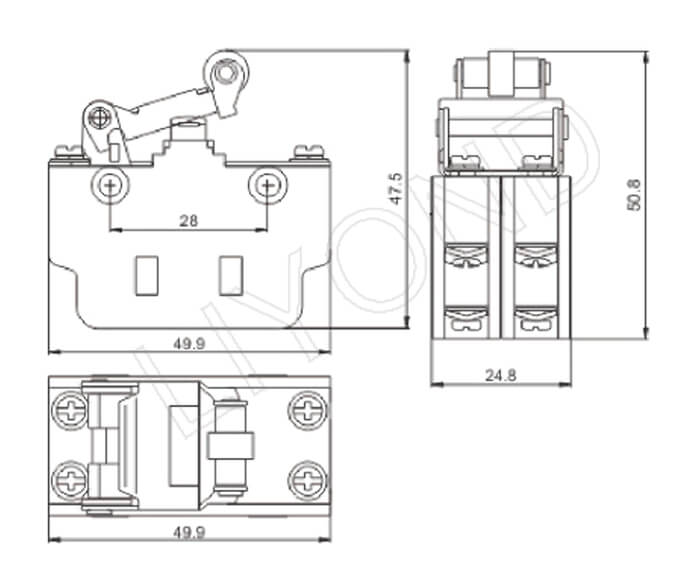In industrial automation control, limit switches serve as key “sensing” components. They precisely detect changes in an object’s position, converting mechanical displacement into electrical signals, thereby achieving accurate control and effective protection of mechanical equipment. Understanding what is a limit switch and how does it work is crucial for mastering this important component in industrial automation.
Limit Switch Working Principle
A limit switch, also known as a travel switch or position switch, is an electrical control device based on a mechanical triggering mechanism. Its core working principle lies in the interplay of mechanical parts and electrical contacts: when the detected object moves to a preset position, its actuating mechanism (such as a lever, roller, etc.) is subjected to external force, driving the internal electrical contacts to perform closing or opening operations. This instantaneous mechanical displacement is precisely converted into an electrical signal, providing crucial position feedback for automation control systems.
Limit switches typically feature two types of contacts: normally open (NO) and normally closed (NC). Normally open contacts remain open when untriggered and close upon activation; normally closed contacts, conversely, remain closed when untriggered and open upon activation. This flexible contact configuration allows them to adapt to diverse control requirements, enabling precise circuit control.

What do Limit Switches do?
Limit switches serve three core functions in automation control:
- Precise Position Control: Limit switches can accurately detect the movement status and position of mechanical equipment, and upon reaching a preset point, they send signals to instruct the equipment to stop or change direction. This function of a limit switch ensures precise positioning and operation, effectively avoiding potential risks like collisions and overloads.
- Equipment and Personnel Safety Assurance: By setting safety limits, when equipment movement exceeds a safe range, limit switches can quickly cut off power or activate emergency stops, effectively preventing equipment damage and personal injury. This immediate safety function is particularly crucial in high-risk environments like chemical plants and mines.
- Enhanced Automation Control: As key feedback components for automation control systems (e.g., PLCs, frequency converters), limit switches provide real-time position signals. This enables control systems to dynamically adjust equipment operation, helping to achieve higher levels of automated production and ensure the continuity and stability of production processes. This illustrates what limit switches do to optimize control.
What Are Limit Switches Used For?
With their robust and reliable design and broad adaptability, limit switches have found widespread application across numerous industrial and civilian sectors:
- Industrial Production Lines: Used to detect the precise position of workbenches and workpieces, driving the automated execution of subsequent processes and ensuring the seamless connection of production flows.
- Machine Tools: Real-time monitoring of machine tool cutter or component travel and position, preventing over-travel and ensuring equipment and processing accuracy.
- Hoisting and Conveying Machinery: In equipment like elevators, cranes, and conveyor belts, they serve as upper/lower limits and travel protection, effectively preventing over-winding, over-running, and other dangerous situations.
- Safety Gates and Guards: Widely used in industrial equipment for detecting the open status of safety gates and guards. Should safety measures fail, they immediately send signals or stop equipment operation, ensuring operator safety.
- Elevators and Transportation: In elevators, for floor and car position detection, and in traffic signal control and vehicle positioning, they provide precise and reliable position feedback, ensuring the safe and efficient operation of systems.
The diverse uses of limit switches provide indispensable assurance for the precise control and safe operation of various automated equipment.
Conclusion
In summary, limit switches are indispensable position signal detection components in industrial automation. Their mechanical triggering-based working principle enables them to play a crucial role in precise position control, equipment and personnel safety assurance, and achieving advanced automation control. Looking ahead, with the deepening development of smart manufacturing and the Industrial Internet of Things, the performance of limit switches will continue to be optimized, and their application potential will further expand, contributing greater power to promoting the continuous progress and safe, efficient operation of the industrial automation field.

